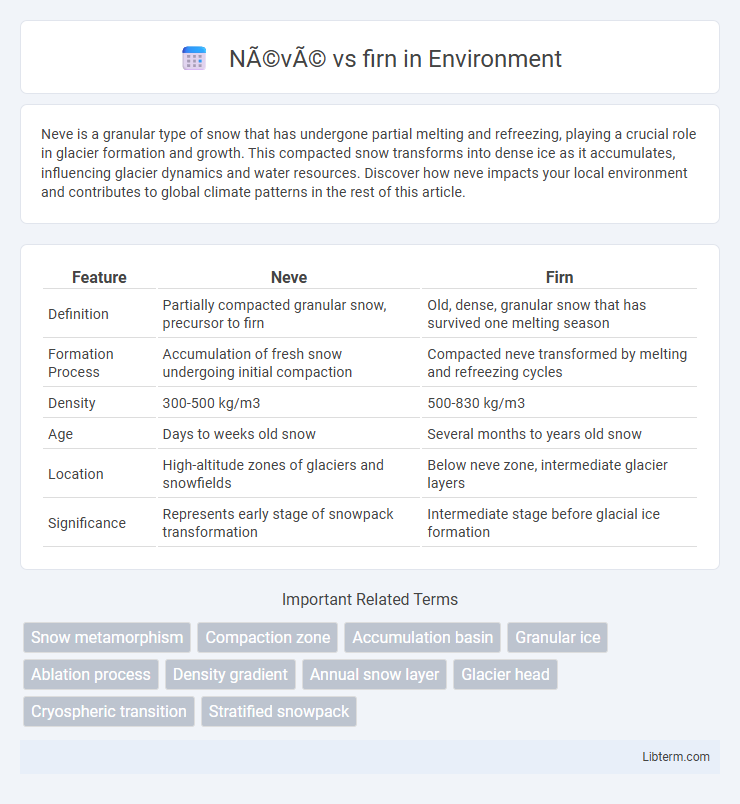Neve is a granular type of snow that has undergone partial melting and refreezing, playing a crucial role in glacier formation and growth. This compacted snow transforms into dense ice as it accumulates, influencing glacier dynamics and water resources. Discover how neve impacts your local environment and contributes to global climate patterns in the rest of this article.
Table of Comparison
| Feature | Neve | Firn |
|---|---|---|
| Definition | Partially compacted granular snow, precursor to firn | Old, dense, granular snow that has survived one melting season |
| Formation Process | Accumulation of fresh snow undergoing initial compaction | Compacted neve transformed by melting and refreezing cycles |
| Density | 300-500 kg/m3 | 500-830 kg/m3 |
| Age | Days to weeks old snow | Several months to years old snow |
| Location | High-altitude zones of glaciers and snowfields | Below neve zone, intermediate glacier layers |
| Significance | Represents early stage of snowpack transformation | Intermediate stage before glacial ice formation |
Introduction to Névé and Firn
Neve is granular, compacted snow that has undergone partial melting and refreezing, serving as an intermediate stage between fresh snow and glacial ice. Firn represents an advanced stage of neve, characterized by increased density and ice crystal growth after prolonged compaction and metamorphism over multiple seasons. Both neve and firn play crucial roles in glacier formation and the accumulation zone of alpine and polar ice sheets.
Defining Névé: Characteristics and Formation
Neve is the granular, partly compacted snow that forms on glaciers during the initial stages of snow accumulation and compaction, typically characterized by its coarse texture and intermediate density between fresh snow and firn. It develops through the gradual compression of snowflakes over an annual cycle, undergoing partial melting and refreezing that expels air and increases grain bonding. Neve serves as the precursor to firn, which is denser and more compacted, representing a progressive stage in the transformation of snow into glacial ice.
What is Firn? Key Features Explained
Firn is compacted granular snow that has survived at least one summer melt season and undergone partial melting and refreezing, representing the transition stage between snow and glacial ice. Key features include its increased density, typically ranging from 400 to 830 kg/m3, and its granular, rounded snow crystals that distinguish it from newly fallen snow or less compacted neve. Firn acts as a critical intermediate in the formation of glacier ice, contributing to the mass balance and dynamics of ice sheets and glaciers.
Formation Processes: Névé vs Firn
Neve forms from the compaction of fresh snow that undergoes partial melting and refreezing, creating a granular, dense layer that persists through seasonal changes. Firn develops from neve when continued compression and recrystallization increase density and reduce air content, marking the transitional stage between neve and glacial ice. The transformation from neve to firn typically occurs over several years as snow is buried deeper within a glacier's accumulation zone.
Role of Climate in Névé and Firn Development
Neve and firn formation are heavily influenced by regional climate conditions, with temperature and precipitation patterns determining their accumulation and metamorphism rates. In colder climates, persistent low temperatures slow snow compaction, allowing neve to transition gradually into firn, which is denser and more granular. Variations in solar radiation and seasonal temperature fluctuations accelerate firn recrystallization, affecting glacier mass balance and long-term ice sheet stability.
Physical Differences: Texture, Density, and Structure
Neve is granular, coarse-textured snow that forms on glaciers' upper layers with a density typically around 0.4 to 0.6 g/cm3, representing partially compacted snow transitioning from fresh snowfall to firn. Firn exhibits a denser, more compact structure with a density range of 0.55 to 0.85 g/cm3, characterized by rounded ice grains and interlocking crystals indicating further metamorphosis. The main physical distinctions lie in texture, where neve is loose and coarse, whereas firn is denser and crystalline, reflecting progressive compaction and recrystallization within the glacier's seasonal snowpack.
Transformational Stages: From Snow to Glacial Ice
Neve represents the initial compacted layer of fresh snow that survives melting and begins the process of densification through recrystallization. Firn forms as neve undergoes further compression and grain metamorphosis, resulting in a denser, granular intermediate stage between snow and glacial ice. This transformational stage is critical in glaciology, as firn ultimately transforms into solid glacial ice through continued compaction and the expulsion of air pockets.
Geographic Distribution of Névé and Firn
Neve and firn exhibit distinct geographic distributions linked to climate and elevation patterns. Neve commonly forms in high-altitude glacial accumulation zones worldwide, such as the Himalayas, Andes, and Alaska, where annual snowfall compacts but has not yet transformed into dense ice. Firn predominates in polar and subpolar regions like Greenland and Antarctica, representing a transitional stage between neve and glacial ice, formed through prolonged compaction and recrystallization over multiple seasons.
Importance in Glaciology and Hydrology
Neve and firn are critical in glaciology and hydrology as they represent transitional snow stages influencing glacier mass balance and water storage. Neve, the compacted granular snow after a season of melting and refreezing, serves as the initial stage before firn consolidation, which is older, denser snow transforming into glacial ice. These layers regulate glacier dynamics and seasonal meltwater release, directly impacting freshwater availability and sea-level projections.
Conclusion: Distinguishing Névé from Firn
Neve forms as compacted snow that has undergone initial melting and refreezing, serving as the transitional stage from fresh snow to glacier ice. Firn represents a more advanced stage, where the snow density increases further over time, typically exceeding 0.55 grams per cubic centimeter, and air pockets begin to reduce significantly. Distinguishing neve from firn hinges on density and metamorphic processes, with firn indicating a more mature, densely compacted snow layer crucial for glacier formation.
Névé Infographic

 libterm.com
libterm.com